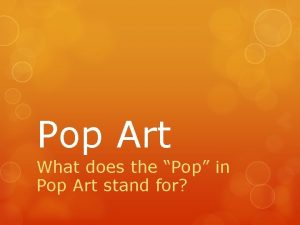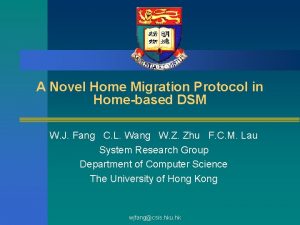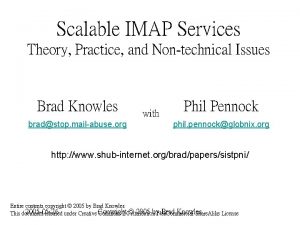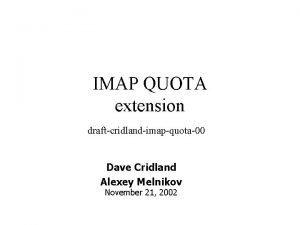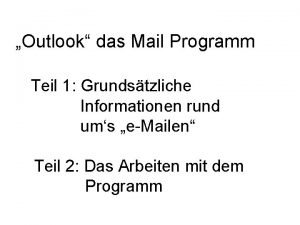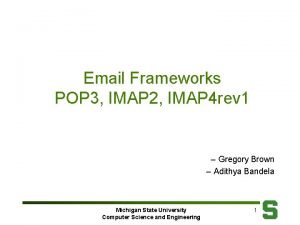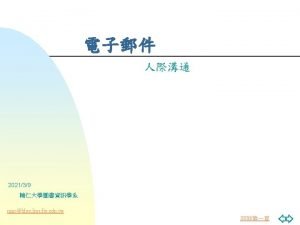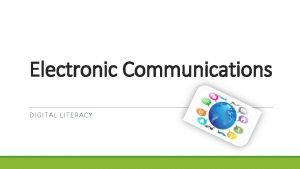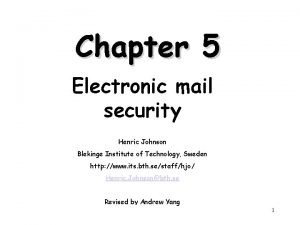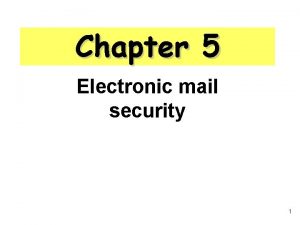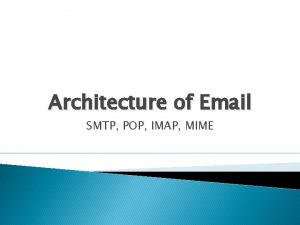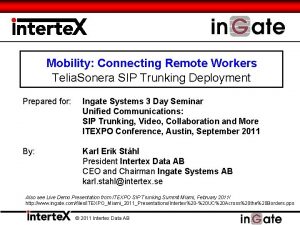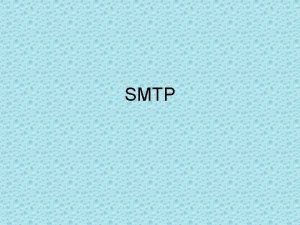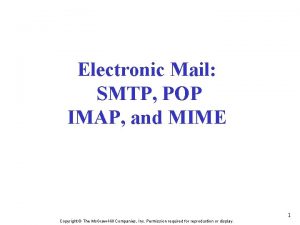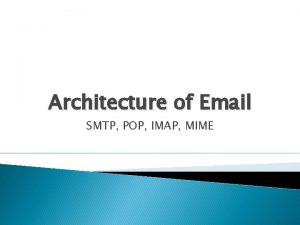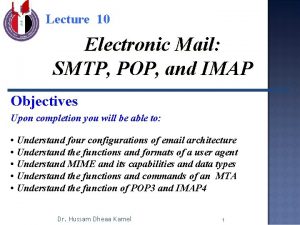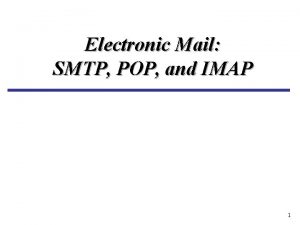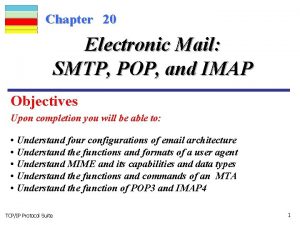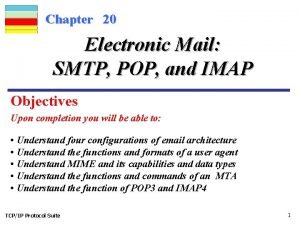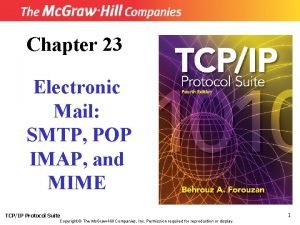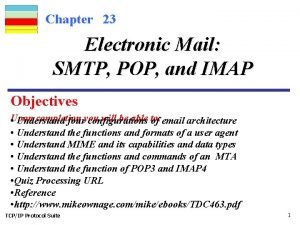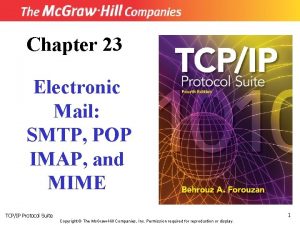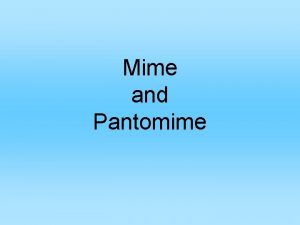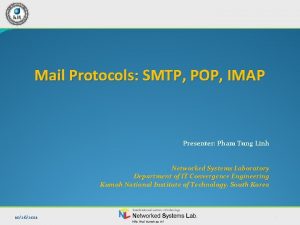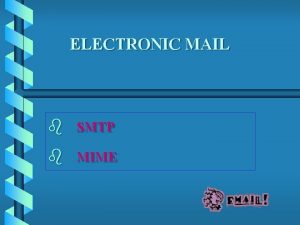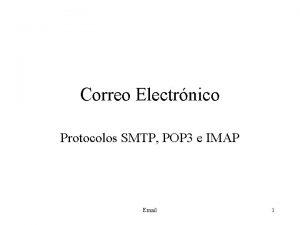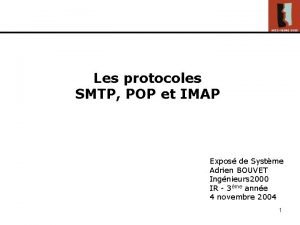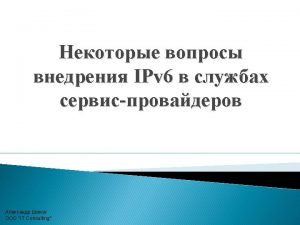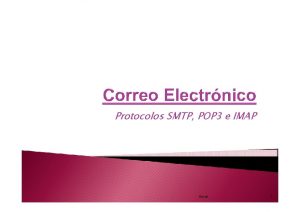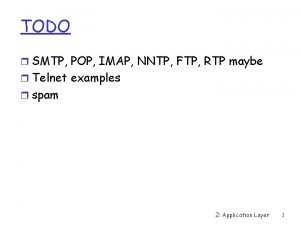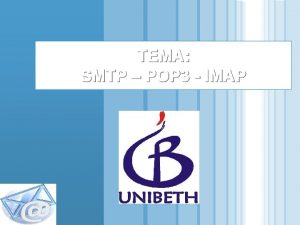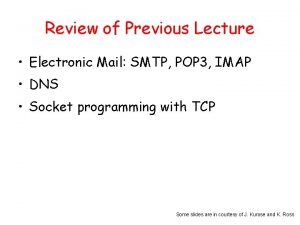Applications Electronic Mail SMTP POP IMAP MIME Presented




























- Slides: 28

Applications: Electronic Mail (SMTP, POP, IMAP, MIME) Presented by-Tarun Lall Badrinath Sai Kumar Praveen

v. Electronic Mail Ø It is one of the most widely used and popular applications. Ø Mail delivery differs fundamentally from other uses of networks. Ø To handle delayed delivery mail systems use a technique called spooling.

v. Electronic Mail(Contd. . ) OUTGOING MAIL SPOOL AREA CLIENT (BACKGROUND TRANSFER) USER SENDS MAIL TCP CONNECTION FOR OUTGOING MAIL USER INTERFACE USER READS MAIL TCP CONNECTION FOR INCOMING MAILBOXES FOR INCOMING MAIL SERVER (TO ACCEPT MAIL)

v. Mailbox Names and Aliases Ø Users specify recipients by giving pairs of strings that identify the mail destination machine name and mailbox address on that machine. Ø The names used in such specifications are independent other names assigned to machines. Ø Mail processing and forwarding.

v. Alias Expansion And Mail Forwarding Ø Most mail forwarding software includes a mail alias expansion mechanism. Ø Aliases increase mail system functionality and convenience. Ø The set of recipients associated with an identifier is called an electronic mailing list.

v. An extension of mail system ALIAS DATABASE ALIAS EXPANSION AND FORWARDING USER INTERFACE USER SENDS MAIL OUTGOING MAIL SPOOL AREA CLIENT (BACKGROUND TRANSFER) USER READS MAILBOXES FOR INCOMING MAIL SERVER (TO ACCEPT MAIL)

Relationship Of Internetworking and Mail • Many commercial computer systems can forward e-mail from sites that do not connect to the Internet. How do these systems differ ? Ø A TCP/IP internet makes possible universal delivery service. Ø Electronic mail systems built on TCP/IP are more reliable than those built by arbitrary networks.

• The alternative form of e-mail delivery uses mail gateways. In such systems the sender’s machine does not contact the recipient’s m/c directly but sends mails across one or more intermediate machines that forward it. • Disadvantage Introduce unreliability & delay • Advantage Interoperability

TCP/IP Standards For Electronic Mail Service • TCP/IP divides its mail standard into two sets. Ø One standard specifies the format for mail messages. Ø The other specifies the details of electronic mail exchange between two computers. What do these standards accomplish? These two standards make it possible to build mail gateways that connect TCP/IP internets to some other vendor’s mail delivery system, while still using the same message format for both.

• The TCP/IP standard for mail messages specifies the exact format of mail headers; it leaves the format of the body to the user. TO SUB

Electronic Mail Addresses There are several formats in which you could specify mail addresses. Ø local-part@ domain-name comer @ purdue. edu Ø Mail gate ways however make addresses more complex for example consider address of the following CSNET operated gateway comer%purdue. edu @ relay. cs. net

• Once the mail reached machine relay. cs. net the mail gateway software would extract the local-part, change the % sign into a @ sign and use result as the destination address to forward the mail. In essence the sites act as if the addresses were parenthesized ( comer%purdue. edu ) @ ( relay. cs. net )

PSEUDO DOMAIN ADDRESSES To help solve the problem of multiple mail systems, each with its own email address format, a site can use domain-style names for all e-mail addresses, even if the site does not use the domain name system. example : uucp-styleaddress@uucp or user@uucp-site. uucp The local mail forwarding software recognizes the special addresses and translates them to address syntax required by the UUCP network software. From users perspective, the advantage is clear: all electronic addresses have the same general format independent of the underlying communication network used to reach the recipient.

but such addresses only work where local mailers have been instructed to map them into appropriate forms and only when the appropriate transport mechanisms are available. Even though psuedo-domain mail addresses have the same form as domain names, they can only be used with electronic mail-one cannot use the domain name system to resolve a psuedo-address into an underlying IP address.

SIMPLE MAIL TRANSFER PROTOCOL(SMTP) • In addition to message formats, the TCP/IP protocol suite specifies a standard for exchange of mail between machines. • The standard specifies the exact format of messages a client on one machine uses to transfer mail to a server on another. • SMTP focuses specifically on how the underlying mail delivery system passes messages across an internet from one machine to another.

• • • It does not specify how the mail system accepts mail from a user or how the user interface presents the user with incoming mail. Also it does not specify how mail is stored or how frequently the mail system attempts to send messages. communication between client and server consists of readable ASCII text. SMTP rigidly defines the command format, humans can easily read a transcript of interactions between a client and server. Initially a client establishes a reliable stream connection to the server and waits for the server to send a 220 READY FOR MAIL message. If the server is overloaded, it may delay sending the 220 message temporarily. Upon receipt of 220 message, the client sends a HELO command. The end of line marks end of command. The server responds by identifying itself.

• Once communication has been established, the sender can transmit one or more mail messages, terminate the connection, or request the server to exchange the roles of sender and receiver so messages can flow in opposite direction. • The receiver must acknowledge each message. It can also abort the entire connection or abort the current message transfer. • Mail transactions begin with a MAIL command that gives sender identification as well as a FROM: field that contains the address to which errors should be reported. • Response 250 means that all is well. The full response consists of the text 250 OK. • After a successful MAIL command, the sender issues a series of RCPT commands that identify recipients of mail message. • The recipient must acknowledge each RCPT command by sending 250 OK or by sending the error message 550 NO such user here.

• After all RCPT commands have been acknowledged, the sender issues a DATA command. In essence, a DATA command informs the receiver that the sender is ready to transfer a complete mail message. • The receiver responds with message 354 start mail input and specifies the sequence of characters used to terminate the mail message. It consists of 5 characters: carriage return, line feed, period, carriage return, and line feed. • consider the following example: • suppose user smith at host Alpha. EDU sends a message to users jones, green and brown at host Beta. GOV. • The SMTP client software on host Alpha. EDU contacts the SMTP server software on host Beta. GOV and begins the exchange as shown: S: 220 Beta. GOV Simple Mail Transfer Service Ready C: HELO Alpha. EDU S: 250 Beta. GOV

• • C: MAIL FROM : <smith@Alpha. EDU> S: 250 ok • • C: RCPT To: <Jones@Beta. GOV> S: 250 ok • • C: RCPT To: <Green@Beta. GOV> S: 550 No Such User Here • • C: RCPT To: Brown@Beta. GOV S: 250 ok • • • C: DATA S: 354 Start Mail input; end with <CR><LF> C: …. sends body of mail message…. C: …continues for as may lines as message contains C: <CR><LF> S: 250 ok

• C: QUIT • S: 221 Beta. GOV Service Closing transmission channel • SMTP is much more complex because if a user has moved, the server may know the users new mailbox address. SMTP allows the server to inform the client about the new address so the client can use it in future. When informing the client about a new address, the server may choose to forward the mail that triggered the message, or it may request that the client take the responsibility forwarding.

Mail Retrieval • SMTP scheme- Server should remain ready to accept e-mails all the time. • How can a user receive e-mail without a permanent connection? – User assigned a mail box on computer that has permanent internet connection. – User forms dialup connection and runs protocol that receives messages from permanent mailbox.

Post Office Protocol • Protocol to transfer e-mail messages from mailbox to local computer. • User invokes a POP 3 client, which creates a TCP connection to a POP 3 server on the mailbox computer. • Computer with permanent mailbox must run 2 servers– SMTP( Accepts mail sent to user) – POP 3 (Allows to extract messages from mailbox).

IMAP 4 • Internet Message Access Protocol is an alternative to POP 3. • User runs a IMAP 4 client that contacts the server to retrieve messages. • IMAP 4 allows user to dynamically create, delete or rename mail boxes.

MIME • Multipurpose Internet Mail Extensions are defined for transmission of non-ASCII data. • It allows ordinary data to be encoded in ASCII and transmitted in standard email. • MIME header specifies: – Version of MIME used. – Type of data being sent. – Encoding used to convert data to ASCII.

MIME Multipart Messages • Four subtypes for multipart messages: – Mixed • Allows single message to contain multiple messages. • Possible to send text, graphics and sound in single message. – Alternative • Allows single message to include multiple representations of same data. • Useful when sending same message to multiple recipients.

Subtypes for Multipart Message – Parallel • Permits message to include subparts that should be viewed together(Like video and audio). – Digest • Permits a message to contain set of other messages. • E. g. , collection of e-mail messages from a discussion.

Summary • E-mail uses TCP/IP paradigm. • SMTP- Defines how a mail system on one machine transfers mail to server on another. • POP 3 - Specifies how user can retrieve contents of a mailbox. • MIME- Provides a mechanism that allows arbitrary data to be transmitted using SMTP.

 Volny.cz imap
Volny.cz imap What does the pop in pop art stand for?
What does the pop in pop art stand for? Don would always open the mail throw away the junk mail and
Don would always open the mail throw away the junk mail and Priority mail vs priority mail express
Priority mail vs priority mail express Google docshttps://mail.google.com/mail/u/0/#inbox
Google docshttps://mail.google.com/mail/u/0/#inbox Imap hku
Imap hku Scalable imap
Scalable imap Lern saxx
Lern saxx Imap quota
Imap quota Hispeed imap einstellungen
Hispeed imap einstellungen Imap diagram
Imap diagram Imap terra outlook 2016
Imap terra outlook 2016 Telnet imap
Telnet imap Startlogic email settings
Startlogic email settings Imap logineo nrw
Imap logineo nrw Electronic mail security in network security
Electronic mail security in network security Digital communication isp
Digital communication isp Electronic mail security
Electronic mail security What is electronic direct mail
What is electronic direct mail Pengertian email
Pengertian email Electronic mail security
Electronic mail security Kependekan dari electronic mail adalah … *
Kependekan dari electronic mail adalah … * Architecture of electronic mail
Architecture of electronic mail Electronic field production examples
Electronic field production examples Scrip exchange
Scrip exchange Smtp dna
Smtp dna Telia sip trunk
Telia sip trunk Rfc pop
Rfc pop Vp poczta
Vp poczta

